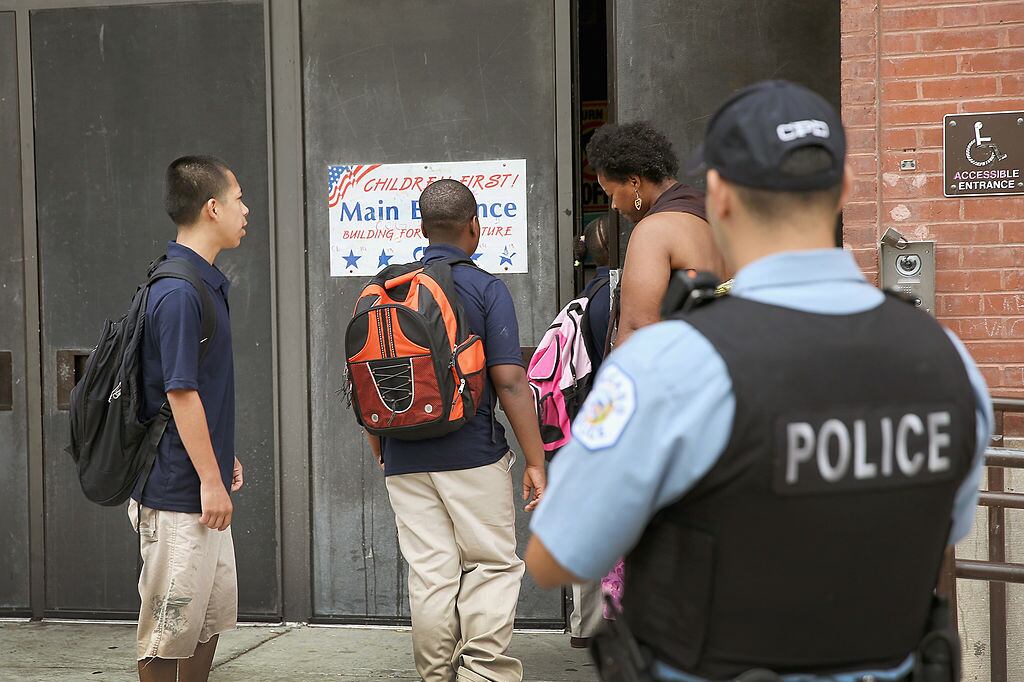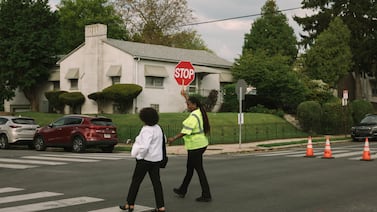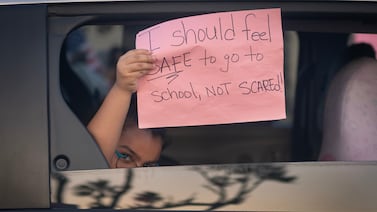For years, the role of police in Chicago schools was murky.
If principals had an issue with an officer, they didn’t know whether to take it up with the district or the police department. It was impossible to know whether officers were qualified to serve in schools. Police at times disciplined students in cases that didn’t involve suspected criminal behavior, leading to confusion over roles and responsibilities.
All of that was supposed to change by last September. Chicago Public Schools and the Chicago Police Department made a slew of reforms intended to bring clarity, accountability, and safety to school policing.
While some campuses noticed immediate changes, a Chalkbeat examination shows that the police-school agreement spelling out reforms remains a work in progress, with uncertainty over some key questions six months past a deadline. We charted progress on the main issues (see sidebar below).
Despite a requirement to screen officers, nearly half have had misconduct allegations sustained against them. Schools still lack a system to register complaints about officers. Some principals remain confused about which situations police can and can’t get involved with. And some students, teachers and Local School Council members said they know little to nothing about the overhaul in school policing.
Still, some school leaders feel grateful to have a clearer road map for how police and schools are supposed to work together.
“There is no more gray area. It is black and white,” said Jammie Poole, principal of Marshall HIgh School, where a video last year captured two officers dragging a 16-year-old student down the stairs and prompted a citywide outcry. “I feel good about the process.”
Chicago Public Schools says it’s committed to engaging with school communities, and that rolling out the changes are part of a multi-step process. The district, for example, has asked principals to communicate details about the school police program at Local School Council meetings, and said it will launch a survey in the spring to solicit feedback.
“The safety and security of all students is the district’s top priority and we remain committed to working with principals, LSCs, educators, and families, to ensure every school community plays an active role in school safety, including new changes to SRO training and selection,” district spokeswoman Emily Bolton said in a statement.
A difference at Marshall
At Marshall High, the change is palpable.
For principal Poole, school police officers used to be an extra pair of adult hands to have around the building when a student needed to be escorted out of the room, or teachers thought it was helpful to have in the cafeteria in case a fight broke out. “We used to be like, you know, if we were down a security guard, we would use our police,” said Poole, who heads a high school of 250 students on the city’s West Side.
That casual approach is gone this year, at Marshall and the other schools with stationed officers.
A different set of officers from last year patrols the hallways. They received training specific to working with young people. The principal himself introduced them to the school community.
Poole said he updated his leadership staff on the new directives for school police, but chose not to do so for teachers or students because he didn’t expect them to have any interaction with officers most of the time.
Despite the tasing incident, Poole said he and the Local School Council chose to keep police officers on campus this year because they have advocated for students who have issues with police outside of school. Marshall students live in a heavily policed neighborhood and may be more likely than students elsewhere to have had negative interactions with officers outside of school.
He had no say in selecting the new officers.
But, he said, “I had the opportunity to speak with them and kind of go through our school and do a walk-through. So I was much more comfortable.”
Now at Marshall, involving a police officer in an incident requires conversations with the principal and several administrators.
“Before anything happens, we crowd into a room and discuss what’s going to happen, but also if it should happen,” Poole said. “First and foremost, can we prevent any type of police escort?”
Sea change
That deliberative process marks a sea change in campus policing.
Chicago embarked on the biggest overhaul of its school policing program in a decade as part of broader police reforms. The cover-up of the fatal shooting of teenager Laquan McDonald in 2014 provoked widespread outrage and protests culminated in a civil rights lawsuit that the city settled last year and that resulted in a federal consent decree.
Among other things, the agreement seeks to turn around a department struggling with low trust in Chicago’s black and brown communities and to bring the cornerstones of community policing best practice onto campuses.
The incident at Marshall High School last year stood out because it was caught on video, but a lack of data and transparency makes it difficult to know how frequently students have negative encounters with police on school grounds.
Most Chicago schools have security officers employed and trained by the district, but only about 70 schools have stationed police officers, also known as school resource officers, trained and employed by the Chicago Police Department. While about 70 schools have officers stationed inside the school, others have police assigned in roving cars.
The new school policing agreement screens officers, lays out who they report to, requires training on dealing with youth, and prohibits officers from engaging in school discipline unless an incident involves criminal conduct.
The Chicago Police Department reviewed the qualifications and records of all officers serving in schools this year to ensure they have an “appropriate” background, spokesman Luis Agostini said. That included a review of disciplinary history to ensure each applicant was fit to serve students and keep them safe, he said.
But a Chalkbeat review of current school-based officers, obtained in the fall, shows that 96% have faced allegations of misconduct, according to the Citizens Police Data Project, a database of police disciplinary records obtained by the Chicago-based non-profit journalism project Invisible Institute.
Those allegations range from excessive force, searches without a warrant, and physical domestic altercations to more minor accusations like unexcused permission and traffic violations. The alleged violations were sustained — found to be true — for 41% of officers serving in schools this year.
For those officers who had allegations against them sustained, Agostini said the police department issued “appropriate discipline and corrective measures commensurate with the violation.”
The department required school officers to reapply for their positions, and veterans and newcomers alike underwent 40 hours of training on de-escalating conflicts, building relationships with young people, understanding disabilities and special education, intervening in youth crises and recognizing implicit racial bias.
What’s happened in Chicago school police reform so far
Complete: Chicago Public Schools and the Chicago Police Department will sign a formal written contract that spells out the role of officers in schools.
The memorandum went into effect Sept. 1, but was posted online in December. It covers police officers’ access to student data, training guidelines, and the chain of command for oversight of school officers.
Incomplete: The city will review the disciplinary history of existing and new officers.
The city undertook a review but did not make clear what kind of record is acceptable.
Complete: The city will develop a set of criteria, including a formal application process, for school-level officers.
Officers must submit a resume to apply to work in a schools. Officers must have at least three years of policing experience, knowledge of juvenile laws and the student code of conduct, previous experience working with youth in a learning environment, the ability to problem-solve in a team environment, quality report writing skills, and enthusiasm for the position.
Incomplete: Officers will have a clear job description that spells out when they intervene in school situations.
The district said that officers will not interfere in discipline matters. However, some principals said they have not received written guidelines for when officers intervene and when they don’t, and a district survey found that 18% of principals somewhat disagree and 4% strongly disagree that they understood SRO responsibilities.
Incomplete: Principals will play a role in selecting school officers.
The agreement stipulates that district commanders coordinate with principals in officer selection. Some principals say they were offered resumes of officers to review, but others say they were not consulted.
Complete: Officers will undergo an annual 40-hour basic training specific to schools.
The district reported that all school officers attended a 40-hour basic training over the summer, led by the National Association of School Resource Officers.
Incomplete: The police department and school district will codify a formal complaint process for the public to file concerns related to school resource officers.
A district spokesperson said CPS and CPD are collaborating to codify the complaint process. A district presentation, however, did not give a school-specific complaint system, and instructed principals to route complaints through the Civilian Office of Police Accountability or the police Bureau of Internal Affairs.
Ambiguous job descriptions
Not all schools have noticed — nor would argue they needed — the change.
In the Norwood Park neighborhood, where many police officers live, Taft High School has minimal tension between officers and students.
Principal Mark Grishaber said the role of officers in a school is only “1% to police a school, but 99% police PR.” That means positive interactions in a school that will pay dividends in the long run, he said.
He didn’t see any changes from last year to this year among the officers who serve at his two buildings. But he said he appreciates having a more clearly defined role for police.
“We have two great officers here at Taft, and I know they are doing a good job because I see kids talking to them all the time,” Grishaber said.
At Sullivan High School in the Rogers Park neighborhood, Principal Chad Adams said at the start of the year he still didn’t know how officers at schools were expected to perform differently this school year. “I don’t think I’ve ever really received any guidance on the officers from the district level,” he said.
In fact, some principals didn’t get clear directives until a webinar that took place this month, five months after the deadline to institute change.
Marshall High’s Poole would like a clear list of what school resource officers do and don’t do, and how a school uses them, so he can post them for his teachers and students.
Mo Canady, executive director of the Alabama-based National Association of School Resource Officers, a leading group training school police, said communication between schools and the police department is key — and so is communication with parents. He cites an example in another district where officers attended family nights and handed out pamphlets describing their role.
“The number one goal of a school resource officer is to bridge the gap between law enforcement and youth,” Canady said. That means letting students know why officers are in the halls.
But even if the district were to publicly share detailed job descriptions, school officials say such guidelines may not apply to the ambiguity of many school situations.
Earlier this month, during a district training on school resource officers for some principals, Benjamin McKay, manager of student discipline support at Chicago Public Schools, acknowledged just that.
”A lot of situations will feel like they are in a gray area,” McKay said, according to an audio recording obtained by Chalkbeat. He noted that a December survey of 59 principals found that half were not entirely clear on the roles and responsibilities of officers in their building. McKay suggested that schools get to know their officers, and tread carefully in involving them in any school-related matters.
The open question
Advice like that has made some school police critics question, again, whether schools need officers, and point to a host of other needs they say could be met with the $33 million the district will spend this year on police in schools.
“That makes me so aggravated and frustrated,” said Anna Lane, a history teacher at Kelly High School on the Southwest Side. ”We could use that money to fund people who could help with the mental health of a student.”
Lane said she has little interaction with officers at her school and has never seen a school police officer at Kelly engage violently with a student. She did once see a young person being led out of the school in handcuffs, and said it was disturbing.
“These are children, I don’t care how old they look,” said Lane. “They should be afforded that sense that these are still babies, we should respect them, their minds are still growing.”
Some students say that school is already a place where they feel hemmed in by the rules they have to follow, a feeling that having police officers only exacerbates.
“We have to follow the teacher’s rules, the school’s rules, and the dean’s rules,” said Derianna Ford, a student at Mather High School. Add in the police, Ford said, and “I have no freedom.”
Ford, who spoke at a press conference against the school police contract ahead of the Board of Education vote in August, also wants educators to consider the deeper reasons students may be acting out.
“A student always has reason why they’re acting out. It may be a problem at home, maybe they have a problem at school,” she said. “We need someone that’s trained to come in and help us sort out the emotions we’re going through.”
She said she has been trying to get a meeting with a school counselor since the start of the school year. “I know there are days where I’m like, ‘I’m so upset, I don’t know what to do,’ and I can’t go to my counselor,” she said. “She’s too busy.”
Gabrielle LaMarr LeMee contributed reporting.






